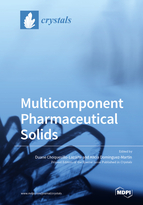Multicomponent Pharmaceutical Solids
A special issue of Crystals (ISSN 2073-4352). This special issue belongs to the section "Crystal Engineering".
Deadline for manuscript submissions: closed (10 December 2021) | Viewed by 29248
Special Issue Editors
Interests: crystal engineering; co-crystals; pharmaceutical salts; multicomponent pharmaceutical materials; crystallization; chemical crystallography
Special Issues, Collections and Topics in MDPI journals
Interests: bioinorganic chemistry; nucleic acids; molecular recognition; multicomponent pharmaceutical materials; co-drugs
Special Issues, Collections and Topics in MDPI journals
Special Issue Information
Multicomponent pharmaceutical materials are solids in which at least one component is an active pharmaceutical ingredient (API). The development of this kind of pharmaceutical solids has certainly attracted interest in the past decade as a promising alternative from the laborious and expensive process of traditional pipeline drug development. The application of crystal engineering techniques into the design of pharmaceutical salts, co-crystals, and other multicomponent materials, in addition to the achievement of more environmentally friendly synthetic approaches, has succeeded in modulating the physicochemical, mechanical, and pharmacokinetic properties of drugs, thereby working toward the enhancement of their clinical performance.
Nevertheless, the study of pharmaceutical solids still presents significant challenges. New multicomponent pharmaceutical materials have come to stay, and we will soon see applications on multidrug resistance or co-drug synergy thanks to rational design. For instance, unraveling structure–activity relationships, the preference for supramolecular synthons, and appropriate co-former and/or solvent selection are still issues that need to be thoroughly studied in order to fully understand, and consequently predict, the formation of pharmaceutical solids with tailored properties.
This Special Issue welcomes original research articles and reviews devoted to all aspects related to the field of multicomponent pharmaceutical solids. Our interests include fundamental to applied research, using theoretical and experimental approaches, the development of synthetic methods, screening of multicomponent materials, structure–activity rationale, salt-co-crystal continuum identification, enhancement in physicochemical/mechanical/pharmacokinetic performance, as well as the functionality and applications of multicomponent pharmaceuticals solids.
Dr. Duane Choquesillo-Lazarte
Dr. Alicia Dominguez-Martin
Guest Editors
Manuscript Submission Information
Manuscripts should be submitted online at www.mdpi.com by registering and logging in to this website. Once you are registered, click here to go to the submission form. Manuscripts can be submitted until the deadline. All submissions that pass pre-check are peer-reviewed. Accepted papers will be published continuously in the journal (as soon as accepted) and will be listed together on the special issue website. Research articles, review articles as well as short communications are invited. For planned papers, a title and short abstract (about 100 words) can be sent to the Editorial Office for announcement on this website.
Submitted manuscripts should not have been published previously, nor be under consideration for publication elsewhere (except conference proceedings papers). All manuscripts are thoroughly refereed through a single-blind peer-review process. A guide for authors and other relevant information for submission of manuscripts is available on the Instructions for Authors page. Crystals is an international peer-reviewed open access monthly journal published by MDPI.
Please visit the Instructions for Authors page before submitting a manuscript. The Article Processing Charge (APC) for publication in this open access journal is 2600 CHF (Swiss Francs). Submitted papers should be well formatted and use good English. Authors may use MDPI's English editing service prior to publication or during author revisions.
Keywords
- Crystal engineering
- API
- Multicomponent materials
- Pharmaceutical solids
- Co-crystals
- Mechanochemical methods
- Solubility
- Screening
- Physicochemical properties
- Co-drugs







